THE HIT SONGS DECONSTRUCTED GLOSSARY
Song Section Details
Intro (I): A section other than a verse or chorus that begins the song.
Verse (A): A section that communicates the song’s narrative (story). It usually contains a similar vocal melody between occurrences but different lyrics.
Pre-Chorus (PC): A section that functions to set-up the ensuing chorus through tension, energy, lyrical and/or melodic shifts. It typically features the same lyrics and similar accompaniment between occurrences.
Chorus (B): A section that provides the summation of a song’s narrative. Typically the most infectious, engaging, and memorable part of the song.
Bridge (C): A section that provides a pronounced vocal, musical, and/or energy level departure relative to other sections in the song and features new lyrics that provide a development in the narrative. Typically only occurs once in a song, though its elements may be recycled in other sections (e.g. outro).
Instrumental Break (IB): A section that features an instrumental hook or solo as its focal point, and is typically longer than four bars. Can contain vocals, but they are typically minimal.
Vocal Break (VB): A section that features a vocal hook as its focal point. Can include elements of the chorus, song title, proper and/or nonsense lyrics, and does not progress the narrative.
Outro (O): A unique section that concludes a song. Can be composed of recycled material from other song sections (chorus, bridge, etc.), unique material that doesn’t appear anywhere else in the song, or a combination of both.
Turnaround (T): A section four bars or shorter that provides a transition between sections.
Post Chorus: A classification of a song section, most typically a vocal or instrumental break, that follows the chorus and houses a unique or recycled instrumental and/or vocal hook.
Bridge Surrogate: In songs that do not contain a bridge, a section of the song (vocal break, instrumental break, or another section) that provides a pronounced musical and/or vocal departure relative to other sections in the song in lieu of a bridge.
“D” (Departure) Section: The classification of a song section that provides a pronounced vocal, lyrical, musical and/or energy level departure compared to the other song sections occurring between two-thirds and three-quarters of the way in. Among the different types of “D” sections are the bridge, which is by far the most popular, a one-off vocal break or instrumental break, or a diversified verse, pre-chorus or chorus compared to how they initially appear within the song.
Vocal Melody
An effective in-section melodic structure boils down to the strategic ordering of melodic parts both within and across lines to attain an effective balance of repetition and contrast, or otherwise stated, memorability and engagement.
In-Section Melodic Structure Visualization
The Hit Songs Deconstructed Melodic Parts Table is a unique visualization tool that illustrates how melodic parts are arranged within a section. It includes each line’s main melodic structure, melodic substructure, lyrics, syllable count and end-of-line rhyme scheme.
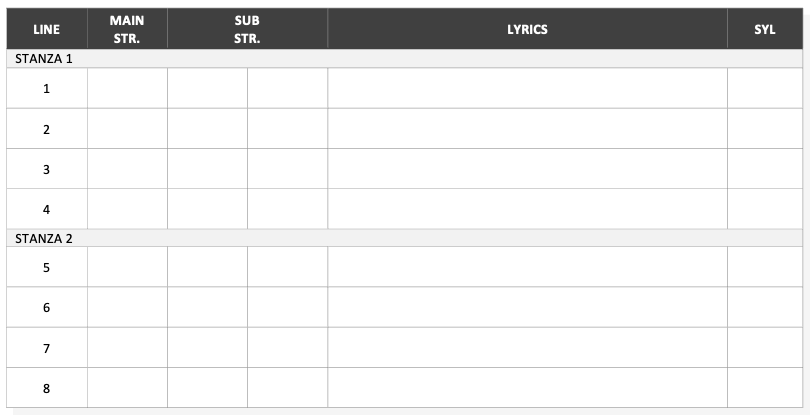
Main Melodic Structure
Main melodic structure provides a macro view of repetition and contrast across full lines within a section. Visualized by uppercase letters and greyscale coloring, lines with the same or highly similar melody will have the same letter, while those with a more differentiated melody will have a different letter.
Example: “California Gurls’” Chorus
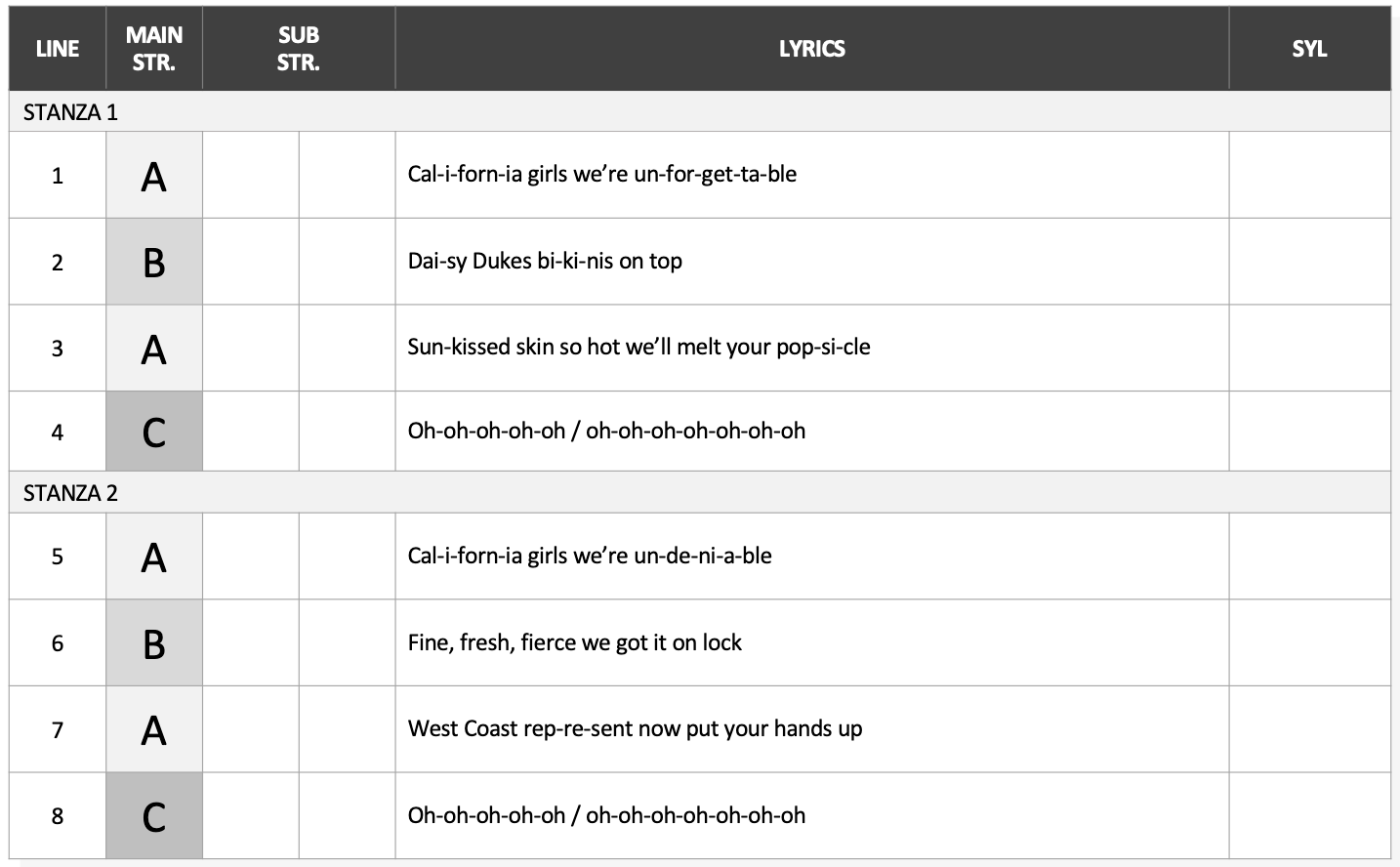
Melodic Substructure & Syllables
Melodic substructure provides a more micro view of repetition and contrast across individual melodic segments both within and across lines. These melodic segments, or subparts as Hit Songs Deconstructed calls them, are determined by segmentation created by rests, melodic changeups and/or rhythmic changeups.
Melodic subparts are visualized by color-coded fields, lower case letters, and numbers:
• Subparts with the same exact melody will have the same letter and number. (e.g., a1-a1)
• Subparts with highly similar, but not exact melodies, will have the same letter but a different number. (e.g., a1-a2)
• Subparts with notably different melodies will have a different letter (e.g., a-b)
In regards to syllables, the number outside of parenthesis represents each line’s full syllable count. The numbers within parenthesis represents the syllable count of each melodic subpart.
Example: “California Gurls’” Chorus
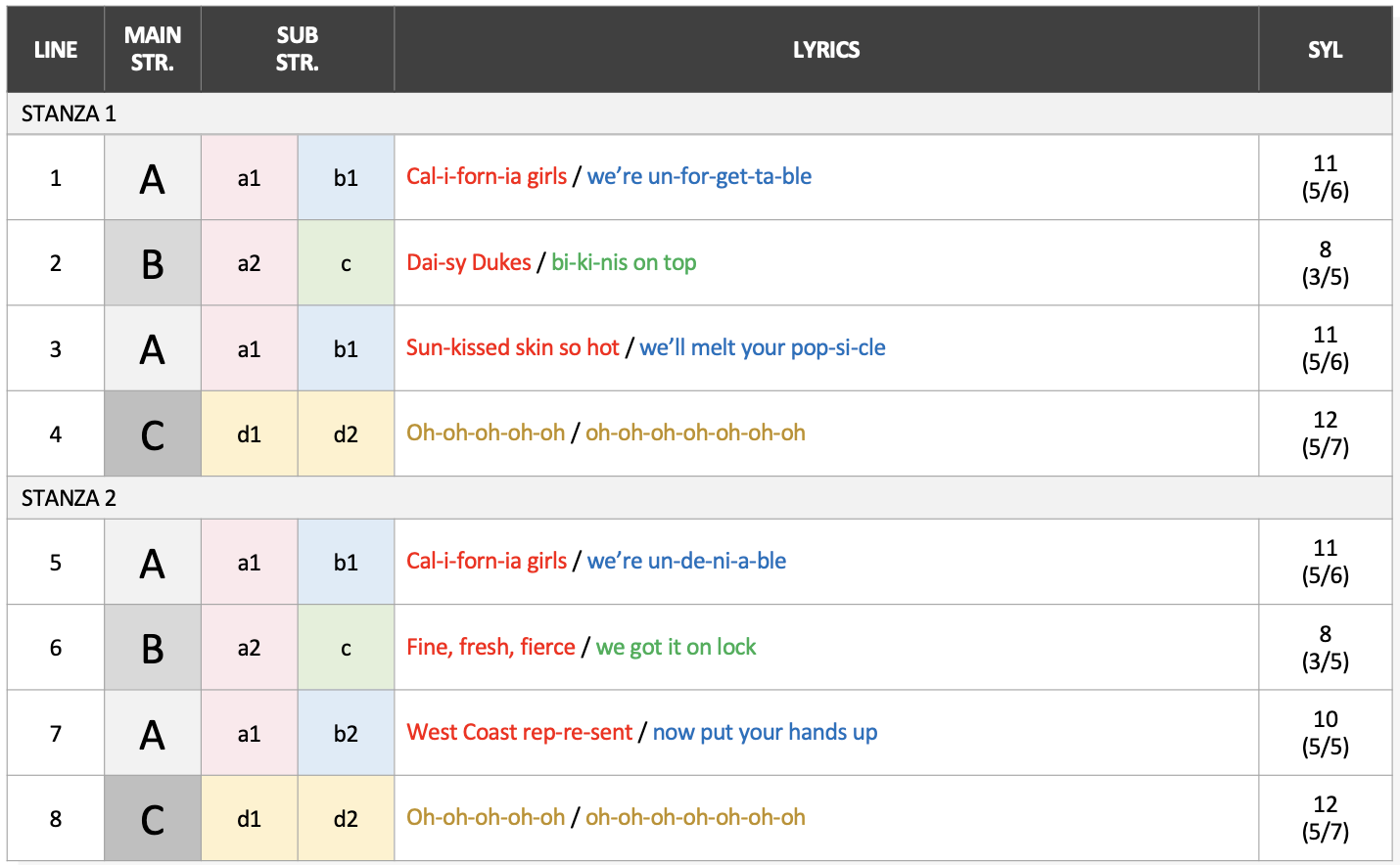
An effective cross-section melodic arrangement boils down to the effective balance of repetition and contrast across sections to heighten both interest and memorability as a song progresses.
Melodic contrast can be achieved through the cross-section variation of melodic range, melodic direction, phrase lengths, rhythms, and complexity. Melodic memorability can be achieved through like-section repetition (i.e., the pre-choruses and choruses typically feature the same melodies with each iteration) and the use of motifs (exact or similar melodic fragments that repeat within and across sections).
Cross-Section Melodic Arrangement Visualization
Cross-section melodic arrangement is uniquely visualized through the Hit Songs Deconstructed Melodic Graph. Song sections are across the top, pitches are down the left, and lines represent melodic patterns with each dot representing a particular pitch.
“Lavender Haze” (Taylor Swift)

Hooks
Focal Vocal Hooks
A focal hook is the standout, focal point of a section; most hit songs contain at least one within their framework. Focal hooks are comprised of three core components: K.I.S.S. ME (Keep It Simple, Singable & Memorable) melodic construction, effective use of hook dressing techniques, and strategic in-section arrangement.
The following are the most common and effective “hook dressing” techniques used to turn K.I.S.S. ME melodies into unforgettable standout hooks:
- “Say It Again” (Repetition): Repeating lyrics with the same or highly similar melody in a back-to-back manner within and/or across lines. Provides a section with a catchy spin, emphasizes and reinforces a key lyric, and/or accentuates a lyric’s emotional impact.
- Song Title: The most common lyrical hook dressing, it is typically connected to and/or provides the narrative summation in one or more of a song’s “hook centers” (i.e., chorus and post-chorus), features a standalone presentation, and is tied to a developed lyrical statement.
- Multipart: Creatively combining two or more distinct melodic and/or lyrical segments to form one cohesive, standout hook. Provides a hook with a catchy, unique, impactful quality; makes a longer-length hook easier-to-digest and remember; and/or brings together two artists in a creative and catchy manner.
- Melodic Spotlighting: Providing a hook with a unique melody and/or rhythm that notably stands out against the surrounding melodies. Typically deviates from one or more aspects of the K.I.S.S. ME principle and is used to bolster a hook’s visibility and impact, heighten a hook’s recognition potential, and create a heightened state of emotion.
- Nonsense Lyrics: Gibberish words that do not have a proper meaning. Commonly used to provide a song with a fun, catchy spin; heighten mainstream familiarity through common nonsense lyrics; provide a unique spin through an original nonsense lyric; communicate an emotion in a clever and creative manner; and/or serve as an engaging A.P.M. (audience participation moment).
- Standout Statement: A lyric independent of the song title that possesses an impactful, captivating, intriguing quality. It is typically presented with a unique melody, provides an engaging lyrical development or twist, and bolsters the narrative summation along with, or in place of the song title hook.
Nano Vocal Hooks
A nano vocal hook is a hook that is featured in a more subtle and less prominent manner than focal hooks. Nano hooks can be used independently of, or in conjunction with, focal hooks to heighten a song’s catchiness and more.
- Background Vocals: Proper or nonsense vocals that appear independently of, or in conjunction with, the lead vocal. They can heighten a section’s catchiness and interest, provide a section with an engaging call & response flow, heighten the memorability of key lyrics and/or melodies, bolster emotional connection, spotlight an artist’s style, put a song in tune with a particular genre or influence, and/or heighten like-section interest as a song progresses.
- E.O.L.A.s (End-Of-Line Accentuators): A similar melodic and/or rhythmic changeup at the end of lines throughout a section. They can heighten a section’s catchiness and interest, provide a cohesive thread & heighten melodic memorability, allow for variation in the melodies preceding the E.O.L.A., spotlight and reinforce a key hook, heighten a lyric’s emotional impact, and/or bolster end-of-line rhyme connection & lyrical memorability.
- A.M.P.s (Alternating Melodic Patterns): A simple melody that alternates between two pitches in either a stepwise or intervallic manner. Along with subtly heightening catchiness and generally being easy to sing along to to, their inclusion can help to make a song more familiar and approachable to mainstream audiences on a subconscious level due to their widespread use.
Foundational Instrumental Hook
A foundational instrumental hook is part of a song’s core accompaniment and delivers the chord progression and/or groove both within and across sections in a catchy focal or nano manner. They can be used to make a song more cohesive and memorable, heighten interest while maintaining familiarity, contribute to a song’s vibe and/or influences, and/or serve as a unique calling card for a song.
Melodic Instrumental Hook
A melodic instrumental hook generally features the same K.I.S.S. ME qualities as vocal hooks and can be used to bolster catchiness, memorability and interest throughout a song in a variety of ways, including: taking center stage (focal), serving in a background and/or embellishing capacity (nano), pairing with a vocal to heighten a hook’s impact, contributing to a song’s vibe and/or influences, and/or serving as a unique calling card for a song.
Hip Hop Beat Hook
A hip hop beat hook is a melodic or chordal hook that is a cohesive component of a hip hop beat, most often in the place of additional chordal accompaniment such as keys, guitar or synth pads. Hip hop beat hooks are repetitive and often present throughout the entirety of a song.
In-Section Hook Arrangement (Chorus)
Effectively setting up a hook or hooks from a vocal, lyrical and/or arrangement standpoint to maximize their arrival and impact, both leading into and within the chorus.
• Up-Top Hook Placement: The hook is introduced at/near the beginning of the section as a pickup or within the chorus itself. Effective at instantly “hooking the listener in” right from the start.
• Down-Below Hook Placement: The hook is introduced at/or toward the end of a section. Effective at allowing lyrical developments to lead into the hook, or providing the listener with a “bonus hook” in addition to a distinct up-top hook.
Full Song Hook Arrangement
In addition to simply having hooks, how hooks are strategically arranged both within and across sections is of the utmost importance.
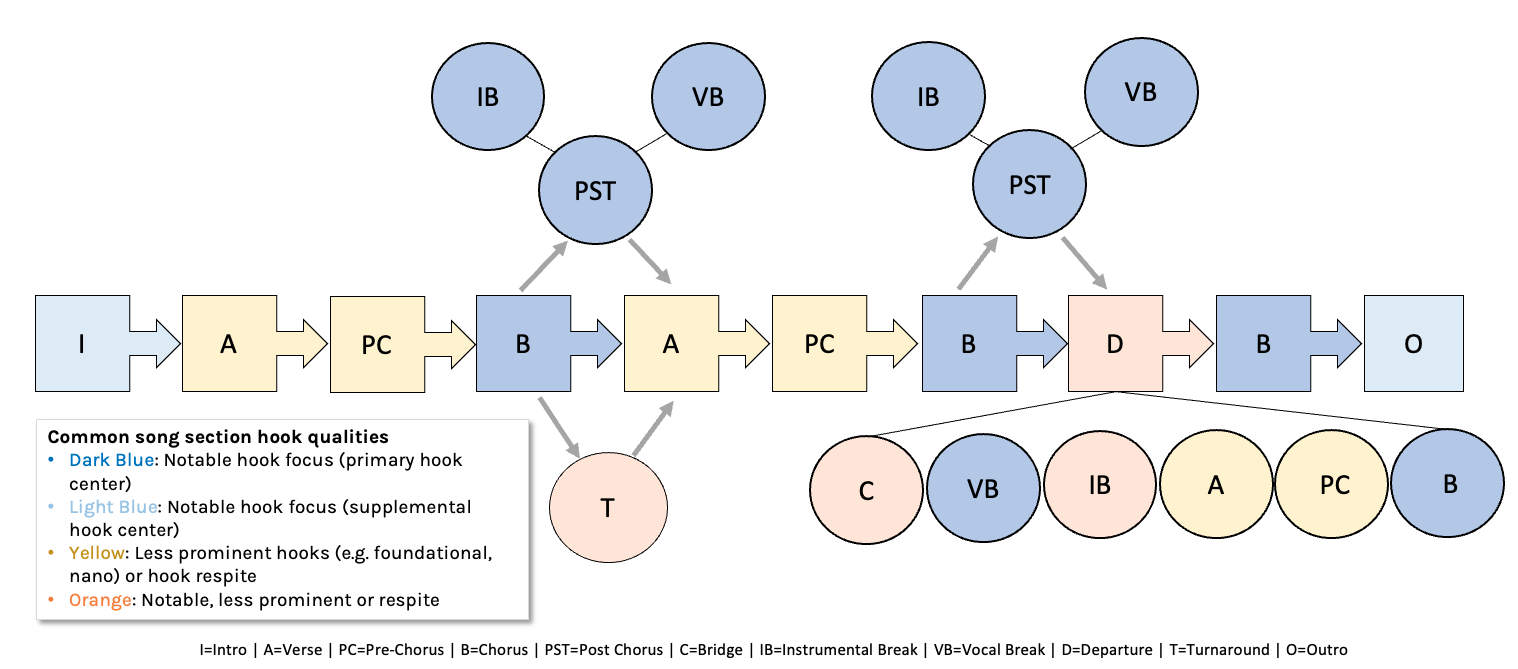
Presenting a hook melody in a particular way in one section, and then reinforcing in a differentiated manner in another. Hook foreshadowing makes a hook already familiar to the listener when they first hear it, heightening their ability to connect with and remember it. Creative reinforcement keeps a hook sounding fresh throughout the song while reinforcing its melody and bolstering its memorability.
Methods of implementation:
• Full Hook: Presenting the full hook melody with a differentiated delivery mechanism (e.g., vocal style, instrument, lyric, timbre, etc.).
• Hook Fragment: Presenting a fragment of a full hook melody (i.e., motif) in the same or differentiated style as the full hook.
• Under-The Radar: Presenting a hook or hook fragment in a non-overt manner (i.e., nano capacity) in one section before taking center stage in another section.
Lyrics
A.I.D.E. is the Hit Songs Deconstructed acronym for action, imagery, detail devices and emotion. Most hit songs use one or more components of the A.I.D.E. principle within and across lines to deliver the narrative in the most profound and compelling manner possible.
• Action: Using verbs to describe a past, present or future physical action in a direct or implied manner.
• Imagery: Describing something or someone in a manner that conjures up an image.
• Detail Devices: Enhancing the lyrics through notable descriptive adjectives, adverbs, idioms, metaphors and similes.
• Emotion: Using lyrics to describe the way something feels in a direct or implied manner.
While most hit songs lean toward the common end of the lyricism spectrum to ensure the listener easily grasps and absorbs what they’re hearing, clever lyricism is also commonly interspersed to heighten interest and engagement.
• Common Lyricism: Straight-forward, basic, easy-to-grasp and understand lyrics (e.g., “I’m angry with you”).
• Clever Lyricism: Providing common, everyday language with an intriguing, impactful spin, often involving more “showing” statements as opposed to “telling” (e.g., “you make my blood boil”).
A.I.D.E. and common/clever lyricism techniques are uniquely visualized through the Hit Songs Deconstructed Lyricism Table (together or independently).
• A.I.D.E.: An “X” signifies that a line possesses a particular A.I.D.E. component. Parenthesis signifies that the A.I.D.E. component is implied or relates to the preceding line.
• Clever/Common: Shows the way the line leans in terms of its clever or common qualities. Note that the degree of cleverness and commonness varies from song to song.
• Narrative Summary: A concise overview of specific lines throughout a section.
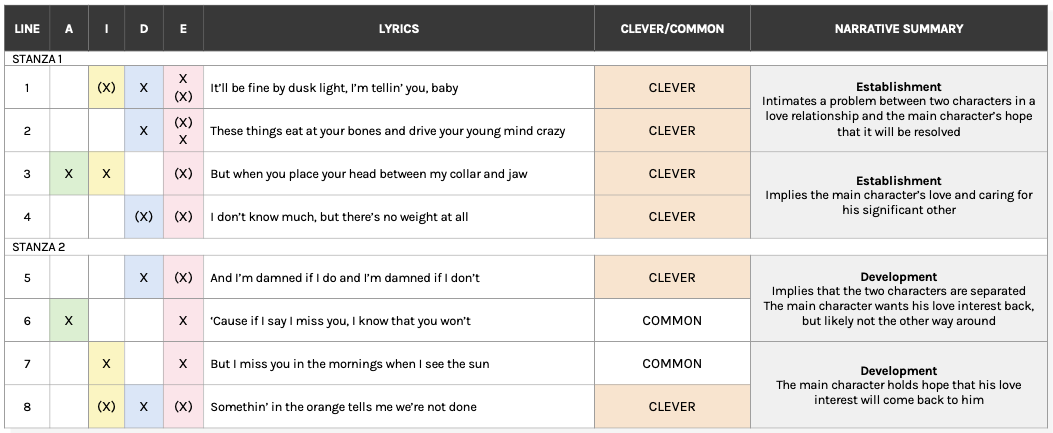
A commonality that many hit songs share is using tried and true lyrical embellishment techniques such as nonsense lyrics, call & response, repetition, and/or adlibs to heighten engagement, connection value and more.
• Nonsense lyrics: Gibberish words that do not have a proper meaning. They can be used to provide a song with a fun, catchy spin; heighten mainstream familiarity through the use of common nonsense lyrics (e.g., “whoah,” “na, na,” etc.); provide a unique spin through an original nonsense lyric; communicate an emotion in a clever and creative manner; and/or serve as an engaging A.P.M. (audience participation moment).
• Call & Response: Can be employed in the lead vocal, background vocal, or combination of the two. Used to create a notable vocal hook, a subtle catchy embellishment, reinforce key lyrics, bolster the narrative’s impact, and/or function as an A.P.M.
• Repetition: Repeating lyrics to bolster catchiness and/or memorability. Can be employed within lines (lyrics are repeated back-to-back, often creating a repetitive “say it again” hook), or across lines (full or partial lines are repeated throughout a section).
• Adlibs: Internal and/or end-of-line adlibs can be used to heighten catchiness, memorability, provide a non-hip hop song with a hip hop influence, showcase an artist’s vocal chops when delivered in a melodically spotlighted manner (i.e., a melisma), and/or serve as a unique calling card for an artist.
The importance of a strong, effective opening line cannot be understated, as it's the listener’s introduction to the song’s narrative.
Among the different things that an opening line can achieve are:
• Grabbing the listener’s attention and hooking them in with a standout statement or lyrical hook.
• Piquing the listener’s curiosity to learn more about the story, which will help ensure that they remain tuned in.
• Setting the scene of the story.
• Establishing the song’s main theme, subject matter, tone and/or vibe.
Prosody
Prosody is ensuring the melody, delivery, instrumental arrangement and lyrics all jibe with one another to create a unified vibe and elicit emotion in the listener. If just one of these elements is off, the song is not going to realize its full potential no matter how good the other aspects are. As the saying goes, “the whole is greater than the sum of its parts.”
That said, some songs intentionally go against prosody at key points to create an intended sense of irony. A notable example is the “Rain Rain, Go Away” nursery rhyme-inspired lyric in “abcdefu’s” scathing chorus.
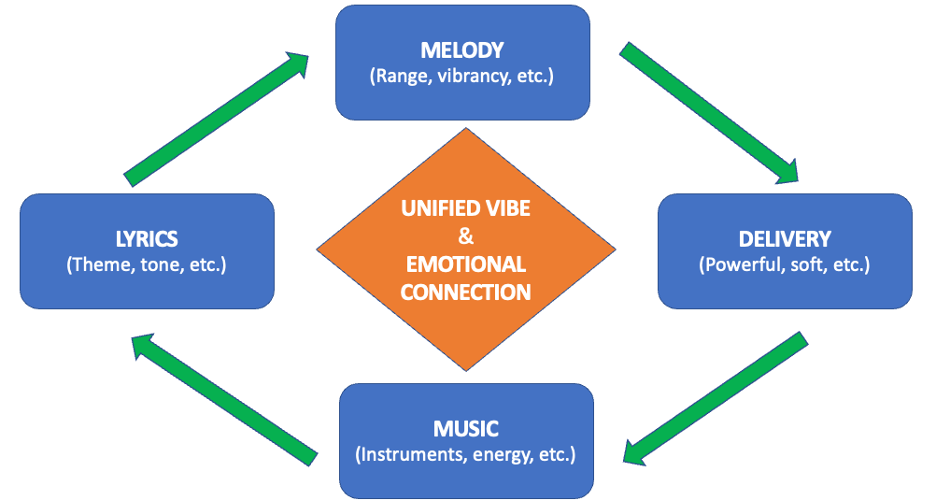
Genre and Influence Fusion
Many of today’s hits feature a combination of disparate genres and influences that enable them to both blend in and stand out in the mainstream music scene. They are put into effect by the qualities of the vocals, instruments, lyrics, and/or overall production.
Genre and Influence Visualization
A song’s genre and influence arrangement is uniquely visualized by the Hit Songs Deconstructed Genre & Influence Fusion Table. It concisely illustrates what genres and influences are featured within a song, where they appear, and their prominence within a section (a large “X” signifies a highly prominent genre/influence, while a small “x” is more subtle).
"Last Night's" Genres & Influence Table

Arrangement and Energy
An important consideration in hit songwriting is the type of instrumental arrangement that will best serve the song. There are two main options – what Hit Songs Deconstructed calls a cohesive arrangement and diversified arrangement. Note, however, that songs won’t necessarily be entirely cohesive or entirely diversified in terms of their arrangement. If they were, they would likely come across as too monotonous or too disjointed. Striking an effective balance between the two will ensure an easy-to-lock in and engaging listening experience.
Cohesive Arrangement
The core instrumental arrangement remains in effect throughout the majority of the song with elements being added or removed from the mix to heighten interest as it progresses. Benefits include creating cross-section continuity and cohesion and keeping the listener locked into a core groove without distraction.
Diversified Arrangement
One or more sections provide a pronounced overhaul in the instrumental arrangement. Benefits include notably heightening the listener’s engagement; drawing attention to specific song sections; and imparting a pronounced shift in vibe, groove, and/or genre influence.
The manner in which the vocals are presented and arranged throughout a song is paramount to its effectiveness and success potential.
Duet/Group Arrangement
Along with heightening interest and engagement as a song progresses, an effectively arranged duet or group vocal can be used to highlight a specific artist or artists, impart a genre/influence shift (i.e., a rapper feature in a pop song), bolster the impact of the storyline, and more.
A song’s energy is affected by a host of factors, including density, timbre, range and rhythm. There are two common energy arrangements utilized by hit songs, depending on what the song warrants:
Dynamic Energy Arrangement
The song features pronounced shifts in energy as it progresses. Along with notably heightening the listener’s engagement, it’s also used to call attention to specific song sections.
Linear Energy Arrangement
The song features minimal fluctuations in energy both within and across sections. This is ideal for groove-based songs, as it helps to keep the listener locked in from start to finish.
First Chorus Energy
There are three energy technique variations used to maximize the impact of the all-important first chorus:
• Big Energy First Chorus: The chorus has a notably higher energy compared to the section that directly precedes it. It is effective in providing the listener with a satisfying high-energy payoff right off the bat.
• Low Energy First Chorus: The chorus has notably lower energy compared to the section that directly precedes, most often the result of a breakdown (sparse) arrangement. Benefits of the technique include “faking out” the listener and heightening their engagement by subverting their likely expectations of a more powerful chorus, providing room for subsequent choruses to develop and grow, and setting up the second stanza of a two-stanza chorus for maximum impact.
• Linear Energy First Chorus: This chorus’ energy remains on par or just slightly above the section that directly precedes it. The technique is most often used to maintain groove and vibe continuity across sections, ensuring that the listener remains locked in.
Energy Visualization
Energy is uniquely visualized through the Hit Songs Deconstructed Energy Graph, providing an easy-to-follow roadmap of how the song’s energy flows. Lower bars represent lower energy, while higher bars represent higher energy. “Waves” represent sectional energy progressions throughout a song, which generally flow from low to high.

S.I.A. is the Hit Songs Deconstructed acronym for section impact accentuator. It is a production and arrangement technique that is used to briefly – and notably – heighten interest and engagement within and across sections.
They typically range from a beat to a bar in length and can consist of a full or partial accompaniment pull to reduce energy; a riser or drum fill to heighten energy; or a combination of the two (i.e., a tension-heightening riser followed by a full accompaniment pull at the end of a pre-chorus to maximize the impact of the ensuing chorus).
The cross-section S.I.A. is typically employed at the end of a verse or pre-chorus to transition into the chorus. However, it can also be used at the beginning of a section, but this is less common. Attributes include heightening the impact of the ensuing section through arrangement contrast, tension, and anticipation; breaking up sections of similar arrangement and/or energy; highlighting a pickup lyric or hook; and/or accentuating the onset of a groove or beat.
The in-section S.I.A. is most commonly employed midway through a section but can be employed elsewhere as warranted. They’re often used to create a jarring and/or surprise moment, highlight a key lyric or melody, accentuate the onset of a groove or beat, and/or provide like-section contrast (e.g., used in verse 2 but not in verse 1).
The “Last Chorus Super S.I.A.” features extra beats tacked onto the end of the section that directly precedes the final chorus which, along with the other S.I.A. qualities, is used to create an unexpected, tension-laden moment that greatly bolsters its impact (e.g., all song sections possessing 4 or 8 bars save for a 9-bar bridge that breaks expectations leading into the last chorus).
Intros
The main purpose of the intro is to cut through airwave clutter, grab the listener’s attention and hook them in while establishing key aspects of the song. There are four main techniques used to achieve this, either independently or in conjunction with one another.
The intro features only minimal elements in the mix. Benefits include:
- Calling attention to and spotlighting key elements at the top of the song (hooks, important lyrics, etc.).
- Providing room for growth in subsequent sections vocally, instrumentally and energetically.
The intro features some, or all, of the instrumental accompaniment that’s housed in the section that directly follows - most commonly a verse and less commonly a chorus. Benefits include:
- Providing cross-section continuity that allows the listener’s full attention to be on the beginning of the narrative (verse) or hooks (chorus) without distraction.
- Establishing and locking the listener into a core groove.
- Establishing the song’s vibe.
- Establishing one or more of a song’s genres and/or influences (e.g., a 1970s-influenced disco beat).
The intro establishes one or more of a song’s key hooks. Variations of the technique include:
- Full hook establishment: One or more of the song’s main vocal or instrumental hooks are fully established in the intro.
- Hook fragment: A fragment of a full hook teases and entices the listener to remain tuned in until they hear the hook in full in a forthcoming section.
Elements are added to, or removed from, distinct segments within the intro. Benefits include:
• Establishing multiple aspects of the song, such as hooks, accompaniment, groove, vibe, genres, influences, etc.
• Allowing the listener to easily and fully connect with each element as they’re methodically introduced across segments (i.e., a solo hook in bar 1 followed by a full groove introduction in bar 2).
• Preventing a messy, hard-to-grasp mix due to the methodical, segmented introductions.
• Maintaining listener interest, especially in longer-length intros.
Outros
The outro is a unique section at the conclusion of a song that either recycles material from other song sections, features a combination of recycled and new material, or more atypically, features entirely new material. There are two main outro techniques used in hit songs, the "wind down" technique and the "ride out" technique.
The outro features a sparser arrangement and lower energy compared to the section that directly precedes it, most typically a chorus or post-chorus. Benefits include:
• Putting the listener gently back down on the ground following a higher-energy section.
• Creating, maintaining or reintroducing a specific groove and/or vibe through a breakdown or fadeout.
• Highlighting a vocalist or key lyric in a lower-energy breakdown arrangement.
The outro features a similar or denser and more energetic arrangement compared to the preceding section. Benefits include:
• Maintaining cross-section groove and/or vibe.
• Riding the listener out on an excited high.
Regardless of an outro’s “wind down” or “ride out” qualities, the “grand finale hook fest” technique is where multiple hooks from multiple sections are uniquely brought together in the outro to conclude the song on a highly catchy and memorable note.
Departure Sections
A “D” (Departure) section is the classification of a song section that provides a pronounced lyrical, vocal, arrangement and/or energy level departure compared to the other song sections, typically occurring around two-thirds to three-quarters of the way in.
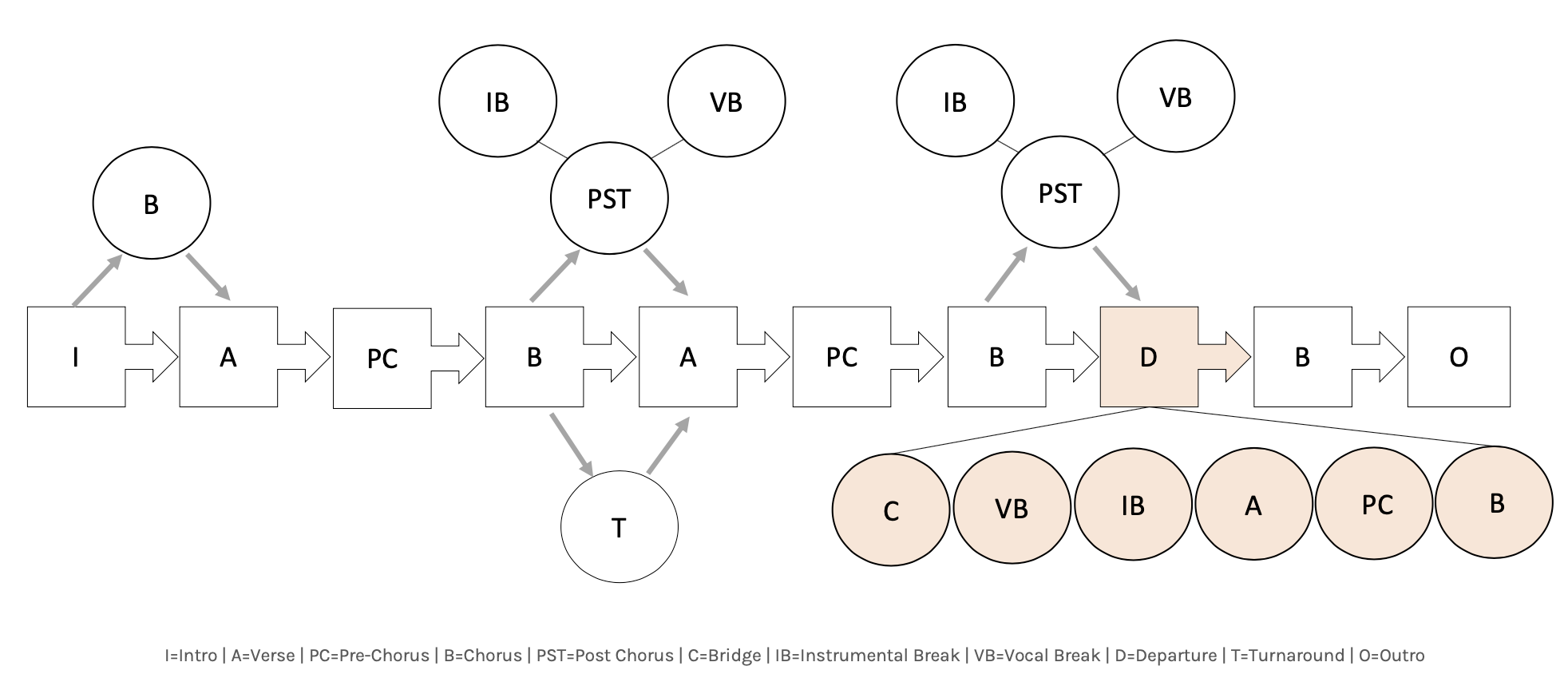
There are various types of “D” sections from which to choose, depending on what best serves the song.
The “D” section possesses entirely unique qualities compared to the other sections in the song. Options include a bridge (most common), a one-off instrumental break (instrumental hook focus or solo), or a one-off vocal break (vocal hook focus).
A pre-existing song section is recycled in a fresh but familiar manner as a “D” section. Options include, but are not limited to, a breakdown pre-chorus or chorus (compared to the other occurrences that feature denser arrangement), or a verse with a changed up instrumental arrangement or featured artist.
While most hits contain one “D” section in their framework, some employ two back-to-back “D” sections. The most common function of a second “D” section is to bring down the song’s energy if the first “D” section’s energy is high. An example of this would be a unique high-energy vocal break followed by a low-energy breakdown chorus first stanza, which would then transition into a high-energy second stanza.
Audience Participation Moments
A.P.M. is the Hit Songs Deconstructed acronym for “audience participation moment.” It is a set point in a song that is designed for the performing artist to engage with the audience in a live setting and heighten their concert-going experience.
Below are some of the most common and effective A.P.M. techniques used in both the hits of today and yesterday .
The performing artist issues the call, and the audience provides the response.
A lyric in the song will cue the listener on what to do (e.g., “throw your hands up in the air, and wave them around like you just don’t care”).
Typically a drum/percussion pattern that lends itself to the audience clapping and/or stomping along.